

![]()
HERDING DOGS OF WESTERN EUROPE
THE HERDING DOGS OF THE NETHERLANDS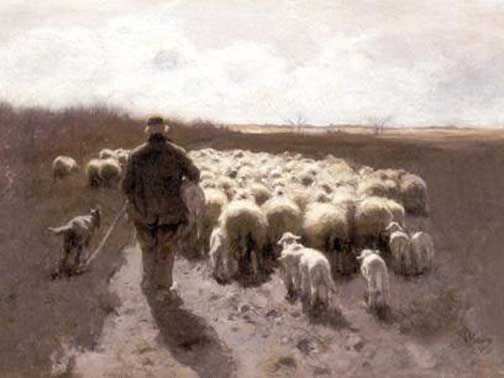
"Tending the Flock" by Anton Mauvé (1838-1888).
Dutch Shepherd or Hollandse Herder
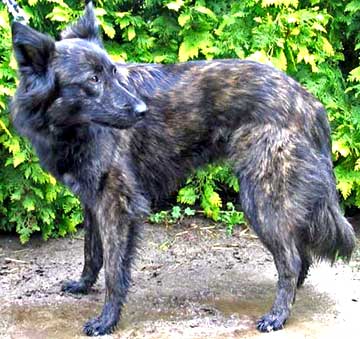
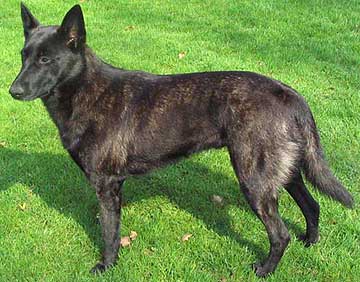 Left, a rough-coated golden brindle Dutch Shepherd and right, a smooth-coated golden brindle Dutch Shepherd, which show this type has not changed an awful lot from its nineteenth century progenitors. (Photos from Wikipedia where the copyright holder of this work published it under the terms of the GNU Free Documentation License.)
Left, a rough-coated golden brindle Dutch Shepherd and right, a smooth-coated golden brindle Dutch Shepherd, which show this type has not changed an awful lot from its nineteenth century progenitors. (Photos from Wikipedia where the copyright holder of this work published it under the terms of the GNU Free Documentation License.)
Dutch Shepherds have been used to move flocks from one pasture to another and to market on the flat Dutch landscape, keeping the sheep out of unfenced cropland. Paintings by Dutch artist such as Anton Mauvé and others show this type of sheepdog. They also worked on farms, keeping chickens and cows out of gardens and acting as watchdogs. Versatility stood them in good stead when flocks became less evident in the countryside about 1900. They were enlisted for police work, war duty, search-and-rescue, and as guide dogs for the blind. Today, in addition, they are shown in conformation and dog sports, and registered with the FCI.
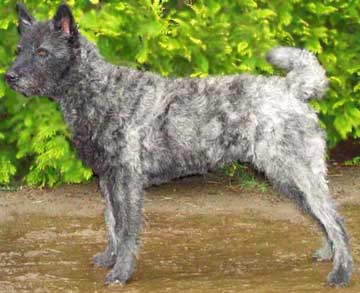 A wirehaired silver brindle Dutch Shepherd. (Photo from Wikipedia where the copyright holder of this work published it under the terms of the GNU Free Documentation License.)
A wirehaired silver brindle Dutch Shepherd. (Photo from Wikipedia where the copyright holder of this work published it under the terms of the GNU Free Documentation License.)
It is said that the Dutch Shepherd is closely related to both the GSD and the Belgian Shepherds, and the resemblance is there. The Dutch Shepherd, however, is a medium-sized dog, smaller than its German and Belgian cousins. In fact, it was originally related to extinct local types of old German herding dogs that had a similar appearance. The Dutch Shepherd comes in three coat types: smooth, rough and wire-haired (note: the gene for bearded is the same one that produces wire haired coats in other breeds, but most wire-haired breeds have short coats), all double-coated, with erect ears and a long tail. In 1937 the long-haired variety was thought to be extinct, but two were found, and subsequent breeding to Belgian Tervurens re-established the coat type. The color is brindle only, silver or gold. The gold is actually tan with black stripes, mask and leather (nose, lips, and eyerims). The silver is light grey with blue stripes, mask and leather. Once it came in solid fawn (tan) as well. Prior to 1909 most Dutch Shepherds were white, but this was bred out by crossing with the GSD and the Belgian Shepherd. Today some dogs have white points, but this is discouraged. Can a breed that required so many out-crosses to other breeds still be called a breed? It isn't unusual, for many breeds today have been rescued from extinction in this manner.
Dutch Sheepdog or Schapendoes
Above, the shepherd leading, the Schapendoes runs behind the flock to keep them moving.
(Photo courtesy of Andrea and Hannes Hirn and reprinted with kind permission.)
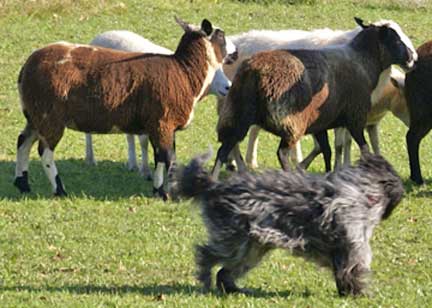 A Schapendoes herding a small flock of sheep. (Photo from Margot Smeenge-Konings and reprinted with kind permission.)
A Schapendoes herding a small flock of sheep. (Photo from Margot Smeenge-Konings and reprinted with kind permission.)
The Schapendoes is descended from farm and herding dogs from the Drenthe area in the northeast of the Netherlands. Unlike most areas of the Netherlands, Drenthe has been sparsely populated and rural since medieval times, and used primarily for farming. The Schapendoes were not a specific breed but local working dogs adapted to the type of work that was required of them. However, they began to be exhibited in the 1870s, which led to more uniformity of looks. This breed became nearly extinct during World War II. The modern breed descends from the few survivors, another rescue tactic which unfortunately narrows the gene pool.
The Schapendoes is a bearded breed said to be related to the Bearded Collie, the Polish Lowland Sheepdog, the OES, the Schafpudel, and other European bearded breeds. It is a medium-sized dog, and comes in many colors with varying degrees of white. There is an International Schapendoes Federation whose goal is to "facilitate an optimal cooperation between the Schapendoes Clubs in order to preserve the health, breed type and good character of our Schapendoes all over the world". Nothing is said about preserving herding ability. It is recognized by the FCI. Schapendoes are used to some extent today as herding dogs.
Below, Schapendoes keep the sheep from getting ahead of the shepherd when moving along a road.
(Photo, courtesy of Andrea and Hannes Hirn and reprinted with kind permission.)
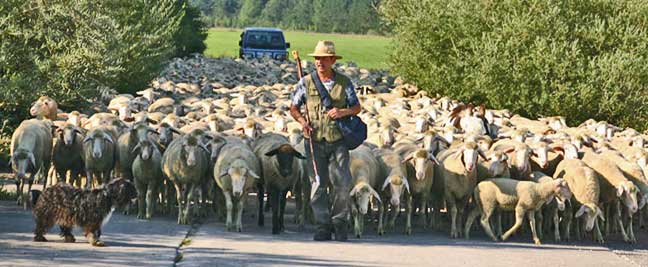
Special thanks to Alberto Bertelli, Andrea and Hannes Hirn, Monique Lefering,
Margot Smeenge-Konings, and Ria Suos for their invaluable help.
Copyright © 2014 by Carole L. Presberg
Resources:
The Association of the Dutch Schapendoes (www.schapendoes.nl/)
Schapendoes Federation http://www.schapendoesfederation.nl
Wikipedia: "Dutch Shepherd Dog" (en.wikipedia.org/wiki/Dutch_Shepherd)
Wikipedia: "Schapendoes" (en.wikipedia.org/wiki/Schapendoes)
Return to
![]()
BORDER COLLIE COUSINS
THE OTHER WEB PAGES WE MAINTAIN
These web pages are copyright ©2014
and maintained by webmeistress Carole Presberg
with technical help from webwizard David Presberg
ALL RIGHTS RESERVED
If you are interested in using ANY material on this website, you MUST first ask for permission.